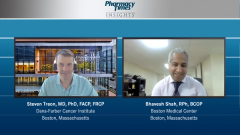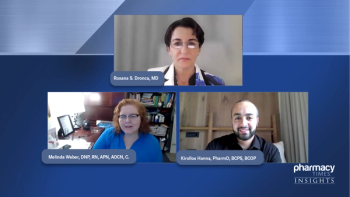
The Molecular Pathogenesis of Waldenstrom Macroglublinemia
An overview of the types of biomarkers that play a role in the manifestation of Waldenstrom macroglobulinemia.
Episodes in this series

Bhavesh Shah, RPh, BCOP: There’s a mutation profile that’s very classic for Waldenstrom macroglobulinemia. Over 90% of patients can have the MYD88 mutation profile, which you can almost use to diagnose somebody with Waldenstrom macroglobulinemia. Are there any other mutations that we should know about?
Steven Treon, MD, PhD, FACP, FRCP: Very proudly, the MYD88 mutation was actually discovered in my laboratory back in 2011. In that year, it was big news, even at the American Society of Hematology [ASH] Annual Meeting. It made the Best of ASH. It was a pivotal discovery. As you mentioned, 95% to 97% of patients actually carry the mutation. We’ve learned a lot in the 10-year span since that time. We’ve learned how the MYD88 mutation signals. This is where we now have some exciting new drugs, like the BTK [Bruton tyrosine kinase] inhibitors, because MYD88 turns on BTK, Bruton tyrosine kinase. There’s another mutation, CXCR4, that’s also relatively unique to Waldenstrom macroglobulinemia. We see it in about 40% of all patients. This also can be disease-modifying. The patients who carry these mutations tend to have very high IgMs [immunoglobulin M] and symptomatic hyperviscosity. But CXCR4 also can oppose the activity of many drugs. BTK inhibitors can be very much affected whether a patient has or doesn’t have the CXCR4 mutation. So it’s not only disease-modifying, but it’s also treatment-modifying.
Bhavesh Shah, RPh, BCOP: We’ll get into the discussion of having the wild type of both of these mutations in terms of implications on BTK resistance. I’d love to talk further about that. How does Waldenstrom macroglobulinemia compare with other B-cell lymphomas in regard to the differences in their characteristics?
Steven Treon, MD, PhD, FACP, FRCP: At many different levels, of course. Genomically, having the MYD88 mutation distinguishes Waldenstrom macroglobulinemia from many other IgM producing diseases. But keep in mind that with marginal zone lymphoma, which is a close cousin morphologically to Waldenstrom macroglobulinemia, a small fraction of these patients can have MYD88 mutations, and so can patients with diffuse large B-cell lymphoma, the ABC subtype. Rarely, patients with CLL [chronic lymphocytic leukemia] can also have it. It’s extremely common for people with primary CNS [central nervous system] lymphoma to carry this mutation.
There are other lymphomas, and it’s important for the pharmacist to keep in mind that the MYD88 mutation isn’t unique to Waldenstrom macroglobulinemia, except that it tends to be very widely found. There can be difference morphologically. The clinical characteristics can differ between patients. But what’s fairly unique to Waldenstrom macroglobulinemia is the IgM protein, because the IgM that’s made by the tumor cells can mediate a lot of the morbidity. As a result, when you’re thinking about therapy, you want to think about ways that you can turn that IgM off and how you can target the tumor cells in a way that you can get that IgM down, and many times get it down very rapidly, especially in somebody with hyperviscosity syndrome.
Transcript edited for clarity.
Newsletter
Stay informed on drug updates, treatment guidelines, and pharmacy practice trends—subscribe to Pharmacy Times for weekly clinical insights.














































































































































































































